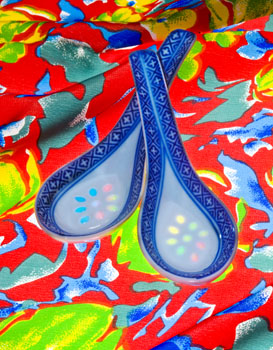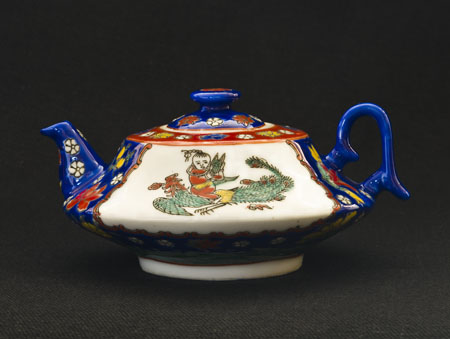
Chinaware is often photographed close-up with a view top revealing intricate detail, but the approach to a particular shot must be determined by its purpose. In most cases china and porcelain objects are photographed for record or catalogue purposes, so the shots tend to be uncluttered and straightforward in composition. However, some still-life photographers incorporate objects of this type into much more creative images.
A single lighting source may suffice if a relatively straightforward composition is envisaged. This approach can be used to produce interesting shadows and good contrast. Softer, more diffused lighting can be used where shadows need to be minimized. If strong shapes and forms are involved, it may be worth emphasizing these characteristics using back-lighting. A second light source should be directed at the front of the subject to fill the shadows and prevent the formation of a silhouette.

Light from above chinaware tends to produce hotspots on the glazed surfaces, and these can be difficult to avoid given the complex curves involved. To a certain extent, hotspots can liven up an image but they also tend to destroy areas of detail in which the viewer may be interested. The best advice is probably to reduce hotspots to a minimum but now worry too much about eliminating them completely. The presence of a bright white background tends to reduce the occurrence of hotspots, but use of a black background enhances contrast.
In the image on the left, an unusual brightly-coloured background was created using a length of Chinese silk. The bright colours were chosen to highlight the translucent "rice grain" design of the spoons. By carefully selecting the areas of the background where the spoons were placed, numerous different colours have been revealed through the rice-grain areas.
It is also worth trying natural light either near a north-facing window (no direct sunlight) or outdoors on an overcast day. An reasonably uniform overcast turns the sky into a massive softbox, and the light can be quite appropriate for this sort of work.

Objects having unusual shapes, or which need to be photographed from a particular angle, may be held in position using small padded cushions or rolls of loose fabric. A support system of this type is not only infinitely variable but also safe when handling valuable items. If the object being photographed is delicate or particularly valuable, the photographer should wear white linen gloves to avoid any possibility of damage.
The Vietnamese tea-pot on the right was photographed on a black velvet background that was carefully arranged over the back of an upright dining room chair in a darkened room. The tea-pot was actually positioned on the seat of the chair and the background material was smoothed into a gentle transition from the horizontal seat to the near-vertical back of the chair. Lighting was provided by a single flashgun which was set to manual mode and fired at a large sheet of white polystyrene foam positioned in front and the the left of the subject. The flashgun was fired manually during a one-second exposure period.






